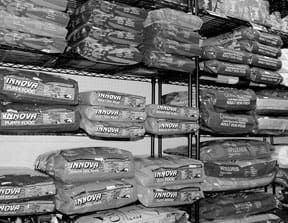Last month, in “A Super (But Secret) Industry,” I discussed the difficulty of getting into a factory where wet pet food is made – a task I have not yet managed to accomplish. Happily, I have been able to tour a few facilities that manufacture dog treats and dry food. This hasn’t resulted in any huge surprises to me, but sure helped me understand the many challenges facing manufacturers who want to produce the very best dog food possible.
As we have described in our annual food reviews since 1998, this task starts with top-quality ingredients. To mix a metaphor, you really can’t make a silk purse out of sows’ ears, chicken heads, bovine tumors, restaurant grease, rendered fat from animals that died on farms, and cheap grain by-products left over from the human food manufacturing industry. Many people say, “Oh, for goodness’ sakes, they are just dogs! Why can’t they eat guts and stuff?” Well, they can, of course, and most dogs do! The vast majority of pet food produced in this country is made with what we would consider to be poor-quality ingredients.
For optimal health, every credible human nutrition expert in the world advocates eating a balanced varied diet of a varying menu of fresh, top-quality foods. There is no biological reason to expect dogs (or any other animal) to be any different. Pet bird experts now realize that an all-seed diet is unbalanced and inadequate for avian health; birds also need access to fresh plant material (fruits, vegetables, green foods such as sprouts, etc.) to thrive. People who keep rabbits as pets now know that alfalfa pellets alone don’t sustain rabbits as well as a diet that includes a variety of fresh hay, root vegetables, and green, leafy vegetables.
Dogs are just the same. A balanced, home-prepared diet of a variety of fresh, healthy ingredients is optimum; a commercial diet made with the same ingredients is leagues better than a commercial diet made with cheap fats discarded from restaurants, inexpensive carbohydrates produced as waste from the brewing industry, and plant proteins such as corn gluten meal (animal proteins have a much more complete amino acid profile than plant proteins).
Of course, the best ingredients cost a lot, and a reliable supply may be difficult to find. Pet food makers who are committed to producing foods for the top end of the market have to continually hunt for ingredients that meet their standards – and be prepared to reject shipments that fail to pass their inspection.
We strongly believe that ingredient quality is the key to a dog food’s quality, as well as the criterion that is easiest for the average consumer to judge, based on a simple review of the ingredients listed on the label. See “WDJ’s Dry Dog Food Selection Criteria,” page 4, for a detailed description of what is desirable and what is best avoided when scrutinizing the ingredients’ panel on your favorite dog foods.
Good manufacturing practices
Ingredients aren’t the whole story, of course. A company that spends the lion’s share of its budget on the ingredients for its foods, but, as one example, expends few resources on laboratory testing to confirm the product meets its label guarantees, may cause the food to flunk inspection by state feed control officials and stop its sale.
Tough standards (and top compensation) for employees, good employee management, superior packaging, proper storage, reliable transportation, smart marketing, education of sales staff at retail locations, knowledgeable and responsive customer service and support . . . these are all areas where a company needs to shine to garner the long-term support of consumers who will pay top dollar for top-shelf products.
Manufacturers who neglect even one of these areas are just asking for trouble. If your plant employees don’t read well or communicate well with their supervisors and coworkers, they may fail to properly inspect a load of corn that arrives at the plant, allowing toxin-laden grain into production (see “Yes, Dog Food Can Kill” sidebar); or accidentally contaminate production equipment with an improperly diluted cleaning agent; or add a dangerously high amount of the mineral supplement to a batch of food, which can cause a life-threatening overdose in exposed dogs.
Most hazards to the wholesomeness of a pet food can be controlled through rigorous planning and management. However, a company must have the resources and commitment to expend those resources to continuously maintain vigilance over the product management from ingredient purchasing to consumer support.
Consumers have few resources available to determine whether dog food makers have “the right stuff” in these areas. In our opinion, one of the best indictors of a company’s commitment to quality is reflected in its ability to respond quickly and intelligently to consumer questions and concerns. Noncompulsory manufacturing certifications (such as the ones described in the “Further Attributes of a Top-Quality Food” sidebar), are another way a company can unequivocally demonstrate its commitment to quality.
Compare for yourself!
In the “2006 Top Approved Dry Dog Foods” chart we’ve listed some dry dog foods that meet our selection criteria. It’s vitally important that you understand the following points regarding these foods:
• The foods on our list are not the only good foods on the market. Plus, we’ve named just one variety in each line by each maker. Usually, all the other varieties in a given line also meet our criteria.
• Any food that you find that meets our selection criteria (see “WDJ’s Dry Dog Food Selection Criteria” sidebar), is just as good as any of the foods on our list.
• We have presented the foods on our list alphabetically. We do not “rank order” foods. We don’t attempt to identify which ones are “best,” because what’s “best” for every dog is different.
• The proof is in the pudding. If your dog does not thrive on the food, with a glossy coat, itch-free skin, bright eyes, clear ears, and a happy, alert demeanor, it doesn’t matter whether we like it or not.
Using the selection criteria outlined above, and perhaps taking into account some of the “extra credit” criteria listed on the next page, go analyze the food you currently feed your dog. If it doesn’t measure up, choose a new food based on quality, and what works best for you and your dog in terms of types of ingredients, levels of protein and fat, local availability and price. Then, try it and see how it suits your dog.
Our list of approved “Top Dry Dog Foods” is offered as a starting place, and for its value as a comparison to other products you may find.
Also With This Article
Click here to view “How to Compare Nutrient Levels in Canned Dog Foods with Dry”
Click here to view “Your Dog’s Diet: A Dry Food Discussion”
Click here to view “WDJ’s Approved Dry Food List”






